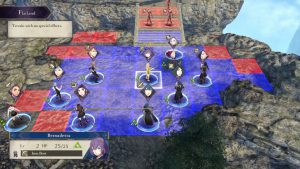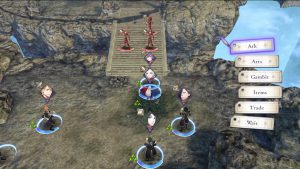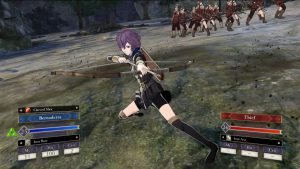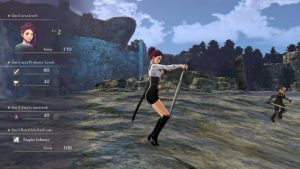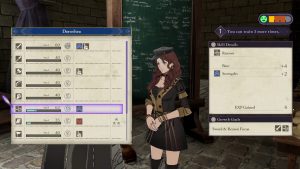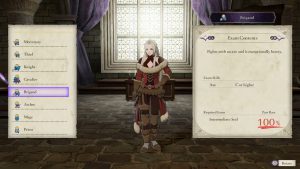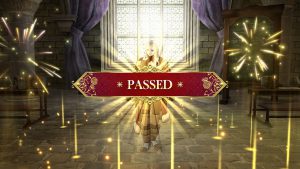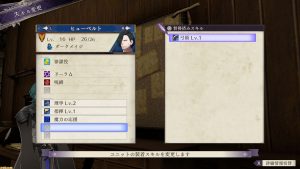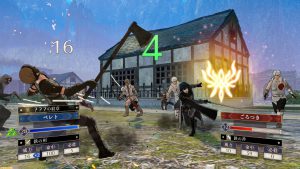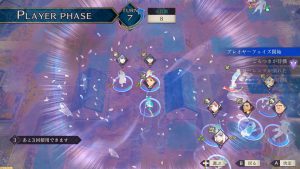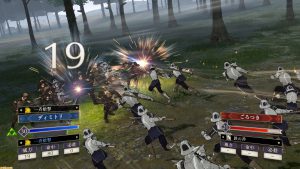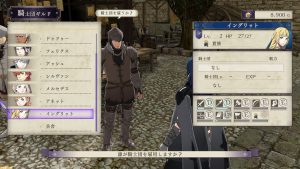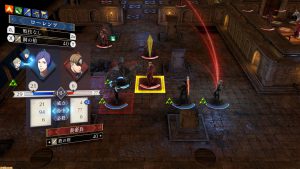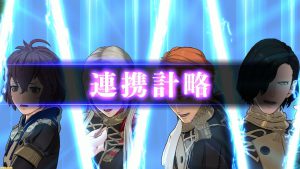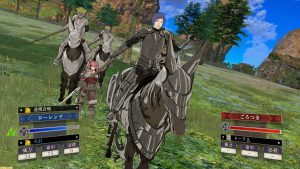Avatar
Similar to Fates, you–the player–are the main character of the game. When you begin the game, you can choose an Avatar to represent yourself. The Avatar can be male or female and you can choose his or her name. At the time of writing, it seems you cannot choose their detailed appearance.
Initially, you’re a mercenary-for-hire working for your father, Jeralt. After a fateful encounter, you awaken to a mysterious power given to you by an enigmatic girl known as Sothis. Afterwards, you are scouted by the Church of Seiros and invited to become a teacher within their prestigious military academy.
Combat Basics
The core gameplay of Three Houses is the same as all mainline games. Battles take place on a grid-based map, with you (blue forces) and the enemy (red forces) each taking turns to move all of your units.
Besides choosing to attack enemies directly, units can select from Combat Arts, which are skills that provide various battle-related effects. For example, Curved Shot seems to boost the user’s attack range by 1 square. Combat Arts previously debuted in Echoes.
After selecting a target to attack, the unit initiating the battle will perform an attack, followed by the targeted unit (if their attack range allows them to counter-attack). If one of the units has 4 or more Attack Speed than the other, they may perform a second attack called a follow-up attack.
After a player-controlled unit defeats a foe, that unit will gain experience points towards their Level, Skill Levels, Class Mastery and Battalion Level. These will all make the unit stronger in their own ways. But if the player-controlled unit is defeated, they won’t be coming back unless you choose Casual Mode.
Character Progression
Skill Levels replace weapon levels in previous games. These are a set of aptitudes that include the traditional weapon levels (Sword, Lance, Axe and Bow plus a new weapon called Fighting), magic (Reason aka Anima or Elemental and Faith aka healing), Authority and movement classes (Heavy Armour, Riding and Flying).
You can raise Skill Levels through combat and studying. It seems all students have access to all aptitudes, but they may have their own strengths and weaknesses in different skills. Like one character may be adept at Sword and Reason, but not so good with Faith.
Once a student has gained enough knowledge, they can take an exam to transfer to a different job class. In other words, they can Reclass. An item may be required to take the exam (such as an Intermediate Seal), and the student may require specific Skill Levels to be raised to have a high pass rate.
You and your students all start off in the Commoner or Noble class, which is a trainee class that excels at nothing but can wield a limited amount of magic. From Level 5, characters can Reclass to base classes such as Myrmidon, Soldier and Fighter. From Level 10, they can Reclass to intermediate classes such as Mercenary and Mage.
Unlike previous games, characters retain their Level after they Reclass. For the most part, they also retain all of their weapon types. However, certain classes excel at using specific weapons. Also, it seems magic is restricted to certain classes only. Gauntlet-type weapons (tied to the Fighting Skill Level) cannot be used while riding.
Abilities and Crests
Characters can equip abilities (originally known as “skills”), which provide a variety of benefits. There are three types of abilities:
- Personal abilities: Innate abilities that each character has at the start. Cannot be removed and there’s only one for each character.
- Class abilities: Innate abilities for each class. They are granted to that class only and disappear once you change class.
- Skill Level abilities: These are abilities that character can learn by increasing their Skill Levels. Unlike class abilities, they can be customised.
Characters can have up to 9 abilities at one time. 1 personal ability, up to 3 class abilities (which are dependent on the class they’re currently in) and up to 5 professor abilities (which can be freely mixed and matched, regardless of your current class).
Some characters also bear crests, such as those passed down by the Divine Seiros and the legendary heroes of Fódlan. Typically, crests are only found on those of noble birth; they are also divided into minor and major versions. Crests seem to have an effect in battle, but their exact properties are currently a mystery.
Divine Pulse
Don’t you just hate making silly mistakes halfway or late into a battle? Thankfully, using the protagonist’s special power, you can rewind time similar to Mila’s Turnwheel in Echoes.
Like the turnwheel, you can rewind whole turns and individual actions within a turn. Also, just like before, there’s a limited number of times you can use this power in each battle. So far, it seems to start at 3, but it wouldn’t be surprising if the limit increased later on.
Battalions
New to Three Houses, units can be supported by battalions, which are groups of generic soldiers that appear alongside–and assist them–during combat. Battalions can directly increase a unit’s stats and let them use special attacks called “Gambits”.
Gambits prevent enemies from counter-attacking and have numerous effects, such as applying negative conditions or even hitting multiple enemies at once. There are also Gambits that buff your teammates instead. Gambits have a very limited number of uses per battle.
Battalions can be managed via the Knights’ Guild. Here, you can hire new battalions or replenish existing battalions. When a unit with a battalion takes damage, their battalion’s health will steadily drop. Once it reaches zero, the battalion’s effects will vanish and Gambits will be inaccessible.
There are many types of battalions for hire, each with different stat boosts and Gambits that can be used. Battalions can also Level Up and get stronger, like units. The battalions a unit can equip depend on the unit’s Authority skill level, similar to weapons.
Co-ordinated Attacks and Assistants
When attacking an enemy, up to 3 nearby allies that can target the enemy from their current position can assist via a Co-ordinated Attack. The allies that are helping out will be shown next to the main attacker’s portrait.
During a Co-ordinated Attack, the main attacker’s combat stats (Attack, Hit Rate and Critical Rate) may be increased, while the enemy’s combat stats may be decreased. Afterwards, all participating allies will gain support points.
If a Gambit is selected when there are nearby allies, a Co-ordinated Gambit will occur. The Might and Hit Rate of the Gambit will increase relative to the number of participants and their support levels. Like Co-ordinate Attacks, up to 3 nearby allies can help out.
Prior to a battle, each character can be assigned an Assistant. Assistants follow their assigned character around and play a purely support role. Essentially, this is the Pair Up system from Awakening and Fates.
The number of Assistants that can be assigned is limited and depends on the protagonist’s Professor Level; initially only one Assistant can be assigned.
Assistants always participate in Co-ordinated Attacks, boosting the user’s combat stats. They may also provide certain bonus effects during battle. The higher the pair’s support level, the better the effects.
- Assistant Follow-Up: At the end of the fight, the Assistant may perform a follow-up attack.
- Assistant Guard: The Assistant may protect the user from enemy follow-up attacks, reducing their damage.
- Assistant Recovery: At the start of each turn, the Assistant may cast the Heal spell on the user.
